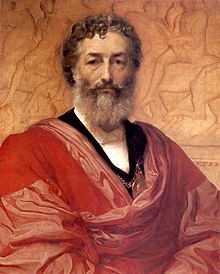Baron Leighton
| The Right Honourable The Lord Leighton PRA |
|
|---|---|

Self portrait of Leighton (1880)
|
|
| Born |
3 December 1830 Scarborough, England, United Kingdom of Great Britain and Ireland |
| Died | 25 January 1896 (aged 65) London, England |
| Education | Eduard von Steinle |
| Known for | Painting and sculpture |
| Notable work | Flaming June |
| Movement | Academicism, Neoclassicism and British Aestheticism http://ateneum.fi/en/frederic-leighton |
| Awards | Prix de Rome, Légion d'honneur |
 |
|
|
|
Frederic Leighton, 1st Baron Leighton PRA (3 December 1830 – 25 January 1896), known as Sir Frederic Leighton between 1878 and 1896, was an English painter and sculptor. His works depicted historical, biblical, and classical subject matter. Leighton was bearer of the shortest-lived peerage in history; after only one day his hereditary peerage ended with his death.
Leighton was born in Scarborough to Augusta Susan and Dr. Frederic Septimus Leighton. He had two sisters including Alexandra who was Robert Browning's biographer. He was educated at University College School, London. He then received his artistic training on the European continent, first from Eduard von Steinle and then from Giovanni Costa. At age 17, in the summer of 1847, he met the philosopher Arthur Schopenhauer in Frankfurt and painted his portrait, in graphite and gouache on paper—the only known full-length study of Schopenhauer done from life. When he was 24 he was in Florence; he studied at the Accademia di Belle Arti, and painted the procession of the Cimabue Madonna through the Borgo Allegri. From 1855 to 1859 he lived in Paris, where he met Ingres, Delacroix, Corot and Millet.
In 1860, he moved to London, where he associated with the Pre-Raphaelites. He designed Elizabeth Barrett Browning's tomb for Robert Browning in the English Cemetery, Florence in 1861. In 1864 he became an associate of the Royal Academy and in 1878 he became its President (1878–96). His 1877 sculpture, Athlete Wrestling with a Python, was considered at its time to inaugurate a renaissance in contemporary British sculpture, referred to as the New Sculpture. American art critic Earl Shinn claimed at the time that "Except Leighton, there is scarce any one capable of putting up a correct frescoed figure in the archway of the Kensington Museum." His paintings represented Britain at the great 1900 Paris Exhibition.
...
Wikipedia
